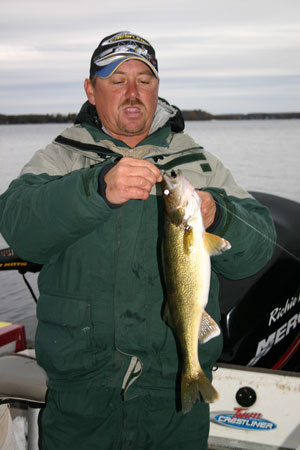Early 'Eyes
by Ron Anlauf
Even early on in the walleye season patterns emerge that can produce
incredible
 action,
if only they are discovered. There are times when it seems like the deck
is stacked against you but the pattern is there, if only you can find
it. Unlocking the secrets to early ‘eyes requires keeping a pulse on the
current conditions, understanding their needs, and reacting accordingly.
action,
if only they are discovered. There are times when it seems like the deck
is stacked against you but the pattern is there, if only you can find
it. Unlocking the secrets to early ‘eyes requires keeping a pulse on the
current conditions, understanding their needs, and reacting accordingly.
The most important and predominate force during the earliest part of
the open water season is the spawning cycle which dictates where
walleyes will be found, and just how active they’ll be. A basic
understanding of the process can get you started in the right direction,
and help you begin putting together a solid early season pattern.
Shortly after ice-out walleyes start heading for suitable spawning areas
like rock rubble shorelines, bars and reefs, as was well as incoming
creeks and rivers. Incoming streams attract the earliest runs of
spawning fish which may occur a couple of weeks ahead (or more) of the
lake run variety. Walleyes will react to the increased flow and increase
in water temps and can come in so heavy that you’d swear you could walk
across the river on them. The process starts with a few eager beavers
showing up first, followed by heavier and heavier runs, and then quickly
thinning out and finally coming to end a week or so after the whole
thing got started.
The next group of walleyes to complete the cycle is the shoreline
variety, whereby the females drop their eggs on fist size rock and
rubble that is exposed to current or wave action. Females will move up,
drop their eggs, and head back to deeper water while the males move up,
release their milt, and stay in the general vicinity. Maybe they stay
put in case more females show up late, or maybe it’s something else. It
doesn’t really matter as long as you know the situation.
Bringing up the rear is the latest of the spawners which do so on off
shore bars and reefs. Reefs that top out in the four to eight foot range
get the most use, but walleyes will spawn in deeper water, depending on
what’s available. On Lake Erie for example, walleyes have been to known
to spawn on reefs that are eighteen to twenty feet deep! That
certainly isn’t the norm but it does happen.
When you add it all up you can see that even though they are all
walleyes, there are separate and distinct groups that do what they do at
different times, and in different areas. It’s important because
knowing where walleyes are in relation to the spawn will allow you to
key on the group with the best chance of producing, and it also gives
you an idea of where to start looking.
Understanding how males and females interact will help you put
together a pattern that keys on a specific size. For example; if your
intent is to catch a lot of fish and size doesn’t matter, or if you’re
looking for walleyes that will fit into a specific slot, a good portion
of your efforts should certainly be dedicated to probing shallow
spawning areas.
If you’re looking for a larger model you may want to start with the
same shallow spawning areas and head a little deeper. The only drawback
is the fact that when females finish dropping their eggs they seem to
lose their appetite and may not get it back for a week or so. If you’re
dead set on chasing down a big hawg you may want to concentrate on the
night run as at least a few big walleyes could still be active once the
sun goes down.
When targeting early season ‘eyes it would be a good idea to keep
their metabolism in mind, which probably isn’t on high. Dead slow
presentations are the rule, and include slow trolling crankbaits,
jigging, and live bait rigging. Tolling crankbaits, dragging jigs
like an 1/16 oz Northland Fireball tipped with a minnow or leech, or
dragging a live bait rig with a chub or shiner can all be effective and
will take a little experimentation to know for sure. Trolling a
crankbait will allow you to cover some water and may be the big ticket
if your faced with acres and acres of potential fish holding areas.
A trigger to a good crankbait bite would be heavy wind and waves
pounding into a rocky reef, bar, or shoreline. Calmer conditions may
call for something completely diferen like long lining jigs or live bait
rigs, especially if you’re dealing with clear water and spooky fish.
Team Cresliner member Richie Boggs of Nisswa, MN spends a lot of time
working clear and heavily pressured lakes and uses a long lining
technique to catch tempermental walleyes; "I'll long line a simple split
shot and leech when walleyes are shallow and things get tough. If
there's enough wind and wave action I can move in as shallow as a few
feet and still catch fish." Another technique Richie uses is to look for
areas wherecreeks or streams dump in; "Walleyes that run the creeks to
spawn will stack up on the closest rock bars, sand flats, and even weed
beds in the main lake."
The key to early season success is to forget what you think you know
and keep an open mind. Even on waters your quite familiar with it’s easy
to miss something, and what you miss could be the best thing going.




 action,
if only they are discovered. There are times when it seems like the deck
is stacked against you but the pattern is there, if only you can find
it. Unlocking the secrets to early ‘eyes requires keeping a pulse on the
current conditions, understanding their needs, and reacting accordingly.
action,
if only they are discovered. There are times when it seems like the deck
is stacked against you but the pattern is there, if only you can find
it. Unlocking the secrets to early ‘eyes requires keeping a pulse on the
current conditions, understanding their needs, and reacting accordingly.